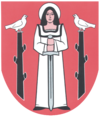 Alternate names: Golub-Dobrzyń [Pol], Dobrin bei Dervents [Yid], Dobrzyń nad Drwęcą [Pol], Dobrin an der Drewenz [Ger], Dobzhin nad Drvents, Gollub [Ger], Golub, Dobzhin, Dobzhin Golub, Dobrzyń-Golub, Golub Dobzhin, Russian: Голюб-Добжинь. דובז'ין על נהר דריוצה- Hebrew. 53°07' N, 19°03' E, Initially two cities, separated by the Drwęca River. The two cities were united in 1951. 1900 Jewish population: 1,938. Yizkor: Ayarati; sefer zikaron le-ayarot Dobrzyn-Golub (Tel Aviv, 1969) and Yizker bletlekh = Dape yizkor (Tel Aviv, 1972). A town in central Poland on the both sides of the Drwęca River in the Kuyavian-Pomeranian Voivodeship (since 1999), previously in the Torun Voivodeship (1975-1998) and capital of Golub-Dobrzyń County with a population of 12,500. We Remember Jewish Golub-Dobrzyn: "On the 14th of September 1939 about 270 Jews were taken out of the prayer houses in our little town and forcefully transported to Bydgoszcz (Bromberg) tortured and executed a few day's later in groups of 40-50 in Fordon outside the city of Bydgoszcz and some were executed in Tryszczyn also not far from Bydgoszcz. They are all buried in mass-graves and amongst them was my oldest brother (Kalman) at that time 15 years of age." slideshow history. [May 2009]
Alternate names: Golub-Dobrzyń [Pol], Dobrin bei Dervents [Yid], Dobrzyń nad Drwęcą [Pol], Dobrin an der Drewenz [Ger], Dobzhin nad Drvents, Gollub [Ger], Golub, Dobzhin, Dobzhin Golub, Dobrzyń-Golub, Golub Dobzhin, Russian: Голюб-Добжинь. דובז'ין על נהר דריוצה- Hebrew. 53°07' N, 19°03' E, Initially two cities, separated by the Drwęca River. The two cities were united in 1951. 1900 Jewish population: 1,938. Yizkor: Ayarati; sefer zikaron le-ayarot Dobrzyn-Golub (Tel Aviv, 1969) and Yizker bletlekh = Dape yizkor (Tel Aviv, 1972). A town in central Poland on the both sides of the Drwęca River in the Kuyavian-Pomeranian Voivodeship (since 1999), previously in the Torun Voivodeship (1975-1998) and capital of Golub-Dobrzyń County with a population of 12,500. We Remember Jewish Golub-Dobrzyn: "On the 14th of September 1939 about 270 Jews were taken out of the prayer houses in our little town and forcefully transported to Bydgoszcz (Bromberg) tortured and executed a few day's later in groups of 40-50 in Fordon outside the city of Bydgoszcz and some were executed in Tryszczyn also not far from Bydgoszcz. They are all buried in mass-graves and amongst them was my oldest brother (Kalman) at that time 15 years of age." slideshow history. [May 2009]
GOLUB-DOBRZYN I: US Commission No. AS 118
Up to 1950 Golub and Dobrzyn were two independent towns on two sides of the river Dzwgey. Up to 1920, they belonged to the different counties of Poland. Now located in Wojewodztno Toninskie at 53º0719º03, 40 km from od Torinia. Cemetery location: ul. Janka Ksasickiego. Present town population is 5,000 to 25,000 with 10 to 100 Jews.
- [This information was almost impossible to read so there may be many errors.] Town: Henryk Kowalski, Kosciuszla 39-burmistr, Ewa Wotricka-ul. Kosciunki 10-Sciritan Unjdu, Rynard Jagaoheinski-Koscuinhi 39 Pnewool, Raviy Miejskiej.
- Local: Mgr. Powet Potom-Konserwator regionalny. Regional: Mgr. Mirostawa Romoniszyn-Konserwator wgewoohla, 87 100 Torvn, ul. Lazienna 8, tel 26692.
- Interested: Wyolnisu? Geodeys and Ungohie Miyskin: Stuizynski Wieskow ul. Bucrka 90.
The earliest known Jewish community was after 1772 with aboiut 300 Jews in 1939. In 1820, the Synagogue was built. In 1858, the community received the statute. In 1923, 116 members of the community left Golub. Living here were 1827 innkeeper Simon Wolff; Wolff Suhtan and Joseph Mendowski, representatives of the community in 1826; Wolff Beniamin, teacher of religion in 1826; Simon Wolff Sulton, A. Isaacksohn, J. Wallengang, representatives of the community in 1846; and Israel Wspes, Joseph Cohn, Gabriel Sultan, representatives of the community in 1855. The Jewish cemetery was established in 1770. The urban crown of a hill by water, part of a municipal cemetery, has no sign or marker. Reached by turning directly off a private road, access is open to all. A continuous fence with a locked gate surrounds the cemetery. Approximate size of cemetery before World War II: 0.0953 ha. No stone visible and there are no known mass graves. Municipality property incorporated into the Catholic cemetery. Properties adjacent are residential. Compared to 1939, the cemetery boundaries enclose the same area. Occasionally, private visitors stop. It was vandalized during World War II. No structures or threats.
Mgr. Maszeno Stocka, 87-100 Tonin, ul. Lyskonskiego 37 e m. 185 completed survey October 25, 1991 after a visit to the site. Persons interviewed: Elibreta Srpejantwlskie and Mouneis Thibert both from Golub-Drobrzyn.
GOLUB-DOBRZYN II: US Commission No. AS 119
The cemetery is located on the road to Chelmno. See I for general information about town. The earliest known Jewish community was probably mid-18th century. 1881 Jewish population was 2,359 among 3,665 inhabitants. The isolated urban crown of a hill by water has no sign or marker. Reached by crossing private property, access is open to all with no fence, wall or gate. Approximate size is 2.6 ha. There are no gravestones visible. It contains no known mass graves. A private individual owns the property is now used for recreation. It was vandalized during World War II. Vegetation overgrowth on the property is not a problem. For survey background information see the cemetery listing above.
